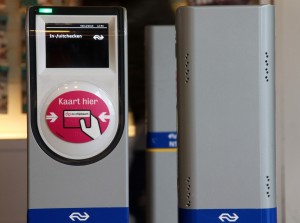RFID
At the TU Delft, one can observe the widespread usage of Radio Frequency Identification (RFID) technology. The campus cards have a RFID tag in them, the doors of the rooms in the university have a RFID reader which is used for access control, while in the library RFID systems are used in multiple ways such as self-checkin and checkout stations, exit sensors, etc. Traveling by public transport in the Netherlands requires OV-Chipkaart which has a RFID tag.
The basic elements of RFID have been known since the Second World War. Airplanes had an identification signal which enabled the ground stations to distinguish their own aircrafts to those sent by the enemy. RFID technology works on the principle of radio frequency transmission-reception. Most RFID systems use the unlicensed spectrum. Low Frequency (125-134.2 KHz) and High Frequency (13.56MHz) bands are used in cheaper systems and these are used for example in animal tagging. Ultra High Frequency bands and ISM bands are used in smart cards and item management (as in the library).
An RFID system is made up of two components – a tag (or transponder) and a reader. A tag, which represents the actual data carrying device of an RFID system, normally consists of a an antenna and an electronic microchip that contains a radio receiver, a radio modulator for sending response back to the reader, control logic, some amount of memory and a power system. There are two types of tags – passive and active. An active transponder possesses its own voltage supply (or battery) while a passive transponder does not. An active tag has a larger reading range and is less commonly used due to its costs and shorter shelf life. A passive tag is only activated when it is within the response range of a reader. The power required to activate the tag is supplied through the contactless coupling unit as is the timing pulse and data. There are also semi-passive tags which have a battery but use the reader’s power to transmit a message back. It must be noted that some tags are programmed by the manufacturer and are ‘read-only’ while others are reprogrammable.
A reader are continually on and typically send a radio signal and listen for a tag’s response. Depending on the RFID system, the reader communicates by Amplitude modulation (AM), Phase modulation (PM) or Frequency modulation (FM). The tag detects the energy and communicated with the reader by varying how much it loads its antenna. By switching the load rapidly, the tag establishes its own carrier frequency and sends back the tag’s serial number and some other information as well. Most tags transmit only a number which the reader sends to a computer. If the tag is used for access control, then the computer will check if the number is in the list of numbers that is allowed access. If it is present, then the computer might energize the solenoid to unlock the door.
References:
1. Lahiri, S. ( 2006). RFID Source Book. IBM Press.
2. https://www.rfidjournal.com/








Comments are closed.